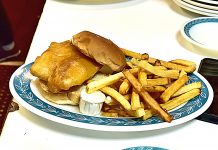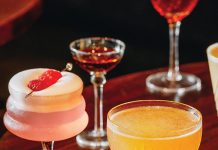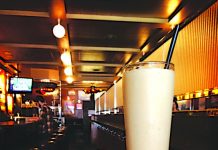 Spring finally arrived in mid-May, slowly shaking off its winter sleep along M-22, the scenic road that follows the western coast of Michigan’s Leelanau peninsula.
Spring finally arrived in mid-May, slowly shaking off its winter sleep along M-22, the scenic road that follows the western coast of Michigan’s Leelanau peninsula.
The daffodils were in full bloom in front of the old shingle-covered The Cove Restaurant in Leland, which sits on a rise above the weathered, gray fishing shanties and cottages that dot the little harbor.
As it heads south, the road whips in and out of the occasional stand of shade trees just breaking into bud. The forest floors at their base were dazzling blankets of white trillium.
About 15 minutes south of Leland on M-22, just beyond Glen Arbor, at the corner of South
Dunn’s Farm and Burdickville roads, the parking lot of a small gem of Michigan dining was full. Although summer hadn’t yet arrived, La Bécasse was in full swing.
La Bécasse is a little village inn that stands among the tall trees and scattered summer cottages just off Lake Michigan. It’s modeled on its counterparts in France, wonderful little family-run restaurants where regional cooking is simple, dense, and totally satisfying.
For almost three years, La Bécasse has been in the hands of new chef-owners, Brooke and Guillaume Hazaël-Massieux. She is from Grand Rapids, where they met after he came to cook in 1996 at the Amway Grand Plaza Hotel. Guillaume was born in Paris and grew up in the West Indies on the French island of Guadalupe. He trained at L’Institut Paul Bocuse in Lyons. After the Amway Grand, where he held assorted kitchen positions, Guillaume moved to Steelcase Corp. and became its executive dining-room chef. Then, in 2001, he moved to the same position at Restaurant Toulouse, a French bistro in Saugatuck.
In the winter of 2004, the Hazaël-Massieuxs heard that former Grosse Pointers Peachy and John Rentenbach, who had owned La Bécasse since the 1980s, were ready to sell and paid them a visit.
“I had never seen it,” Guillaume says. “We used to spend our vacation across the peninsula in Omena. “So, I was surprised to find this side was quite busy. But we loved particularly the dining room because it was simple, quaint, and homey, which is very much like a little French inn.” In the following months, they put together a financial package and bought La Bécasse.
Under the Rentenbachs — Peachy used to run the test kitchen at the Detroit Free Press — La Bécasse had become one of the better-known destination restaurants in the state. The Rentenbachs gave La Bécasse its character, which the Hazaël-Massieuxs have maintained.
Like many up-north restaurants, La Bécasse ran with the seasons and closed from January to May. The new owners have made it a year-round operation. “It has been tough, but so far we’ve done well at holidays and in January and February,” Guillaume says.
With the sale of La Bécasse, which is the French word for woodcock, came the house next door, which had lodged some of the kitchen staff under the Rentenbachs. Since the Hazaël-Massieuxs needed a home, they totally renovated it before Brooke and daughter Margot could move to the area. Brooke now runs the dining room, and has passed the first stage of an exam to be certified a sommelier.
Little has changed in the restaurant dining room. “We painted and changed the art on the walls, but that’s all, really,” Guillaume says. Indeed, the dining room remains simple, with a still life over here, a hanging tapestry there, and an intimacy that is helped, in part, by the tables being fairly close together. Tables are set in white linens, with candles, simple silver, and dishes.
What has changed is the menu. “I wanted to keep it absolutely simple and unpretentious,” Guillaume says. “So I started over; I threw almost everything out.”
He introduced several classic French dishes, but he says he was careful not to go too far. “I wanted to keep the atmosphere and ambience as it was, but I knew it would be impossible to do everything as authentic French country cooking,” Guillaume says. “That would be all kinds of parts of the animal: tongue, entrails, gizzards, blood sausage, and others things. And, although I love all that and eat it, I don’t think we could sell that here. We must accommodate local tastes.”
The menu is indeed different and simple. It offers five first-course choices, two salads, six main courses, four desserts, and a cheese plate. Plus, there are the occasional daily specials, when he finds something to add.
Guillaume’s cooking is notable for its vividness and deep flavors. Everything that came to the table was prepared with great care, attention, and understanding of ingredients. Everything is made in-house, except the bread, which is supplied by Stone House Bread, created and, until just recently, owned by former WDIV-TV anchor Bob Pisor.
On a recent visit, we tried most of the items on the menu. There came a first course, a traditional pâté de campagne — rich, savory, and dense without being thick and like a piece of cold cut, as so many tend to be. Another opening dish of sautéed frog legs served Provençal style in a sauce of tomato and garlic, was succulent and savory, as was yet another dish of shrimp in a tomato sauce with fine, sweet baby leeks.
The soup of the day was a distant relative of a pistou — small pasta, beans, vegetables, and broth — but instead of garlic-and-basil pesto, Guillaume added an emulsion of parsley. One minor complaint: The beans were undercooked, crunchy almost.
For main courses, we tried the seared duck breast with a leg of duck confit served with a vanilla demi-glace. “The vanilla gives it just a touch of sweetness,” Guillaume says, “and I think it adds a great deal.” It does.
Another main course reflects the northern French region of Normandy: Sautéed noisettes of veal in a cream sauce with wild mushrooms. To that, Guillaume adds a square of scalloped potatoes, which he points out, is more from the Alpine region of France. But it all works well together. Also worth trying is the grilled eggplant and polenta dumplings served with a roasted-garlic sauce.
The only dish I found somewhat puzzling was rosemary demi-glace served with a rack of lamb. On their own, the sauce and the meat tasted perfectly fine. The cooking was immaculate. But together, the lamb tasted slightly metallic and mutton-like.
The desserts are superb. Guillaume has retained Peachy Rentenbach’s signature item, profiteroles made with vanilla ice cream. But he has also added an almond pear tart with pâte brisée crust, the success of the evening, along with his tarte Tatin and a crème brûlée finished with a little orange rind.
The wine list has been expanded to 130 offerings and leans far more to French and Australian than to American reds and whites, but with very reasonable prices. In whites, we found Jacqueson Rully 1er Cru Gresigny Cote Chalonnaise for $59. I shudder when I say it, but that’s extremely reasonable for that particular wine in a restaurant. The list also includes 12 champagnes and sparkling wines, a raft of bordeaux, burgundies, and Côtes du Rhônes — a really good offering for a small restaurant.
As for the future, Guillaume says, the food will always remain simple and adventurous. “I don’t want to have some froufrou menu with 1 ounce of food on the plate. I do not have either the will or pretension for that. What I can do is to make food that is as good an adaptation as possible [from the French] to what we have here.”
This new La Bécasse is also an adaptation, that of a bright, fresh new talent grafting himself onto something created by people who cared about food in a previous generation. And, for that alone, it’s well worth a visit.
9001 S. Dunn’s Farm Rd., Burdickville; 231-334-3944. D Tue.-Sat.
|
|
|









